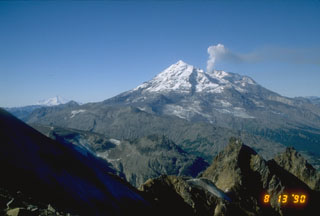Report on Redoubt (United States) — November 2008
Bulletin of the Global Volcanism Network, vol. 33, no. 11 (November 2008)
Managing Editor: Richard Wunderman.
Redoubt (United States) Debris flows, odors, steam, and melt holes in the second half of 2008
Please cite this report as:
Global Volcanism Program, 2008. Report on Redoubt (United States) (Wunderman, R., ed.). Bulletin of the Global Volcanism Network, 33:11. Smithsonian Institution. https://doi.org/10.5479/si.GVP.BGVN200811-313030
Redoubt
United States
60.485°N, 152.742°W; summit elev. 3108 m
All times are local (unless otherwise noted)
In late July 2008 field crews from the Alaska Volcano Observatory (AVO) working around the summit of the volcano smelled hydrogen sulfide (H2S) gas. Then, on 16 September 2008, a pilot flying downwind of Redoubt reported smelling a strong sulfur-dioxide (SO2) odor. A week later, residents of a cabin near Wadell Lake (25 km NE) reported loud noises coming from the direction of Redoubt.
During an overflight on 27 September 2008, scientists observed several fractures and circular openings in the upper Drift glacier that had not been seen before. They also noted that fumaroles atop the 1968 and 1990 lava domes were more vigorous than when last observed in mid-August. A distinct H2S odor was also evident, though no SO2 was detected by onboard instrumentation. The seismic network at Redoubt did not detect any abnormal earthquake activity.
Satellite thermal instrumentation detected warming near the summit craters on 13 October. Fumarolic activity and water flowing beneath Drift glacier on the N flank had produced a 45-m-wide melt or collapse hole at an elevation of about 1,700 m on Drift glacier.
On 2 November a slushy debris-flow originated near the 1966-68 vent. On 5 November AVO raised the Aviation Color Code for Redoubt from Green to Yellow and the Volcano Alert Level from Normal to Advisory because of significant changes in gas emission and heat output during the previous several months. The changes were a departure from the long-observed background activity. In early November, AVO staff began to install additional geophysical equipment and a web camera on the volcano.
Since November, seismic activity has remained low, although the number of low-frequency earthquakes during the previous several months had increased modestly. On 16 December a short-lived steam cloud, rising no higher than the volcano's summit, was reported by an observer in Kenai, 82 km E of the volcano. Clear satellite views during 12-16 December showed nothing unusual. As of 23 December 2008, the Current Aviation Color Code and Vocano Alert Level remained at Yellow and Advisory, respectively.
Geological Summary. Redoubt is a glacier-covered stratovolcano with a breached summit crater in Lake Clark National Park about 170 km SW of Anchorage. Next to Mount Spurr, Redoubt has been the most active Holocene volcano in the upper Cook Inlet. The volcano was constructed beginning about 890,000 years ago over Mesozoic granitic rocks of the Alaska-Aleutian Range batholith. Collapse of the summit 13,000-10,500 years ago produced a major debris avalanche that reached Cook Inlet. Holocene activity has included the emplacement of a large debris avalanche and clay-rich lahars that dammed Lake Crescent on the south side and reached Cook Inlet about 3,500 years ago. Eruptions during the past few centuries have affected only the Drift River drainage on the north. Historical eruptions have originated from a vent at the north end of the 1.8-km-wide breached summit crater. The 1989-90 eruption had severe economic impact on the Cook Inlet region and affected air traffic far beyond the volcano.
Information Contacts: Alaska Volcano Observatory (AVO), a cooperative program of a) U.S. Geological Survey, 4200 University Drive, Anchorage, AK 99508-4667, USA (URL: http://www.avo.alaska.edu/), b) Geophysical Institute, University of Alaska, PO Box 757320, Fairbanks, AK 99775-7320, USA, and c) Alaska Division of Geological & Geophysical Surveys, 794 University Ave., Suite 200, Fairbanks, AK 99709, USA.

